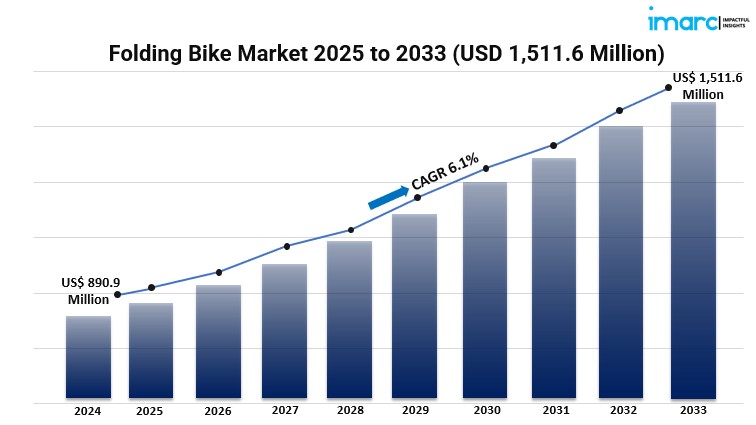The global folding bike market is experiencing robust growth, fueled by increasing urbanization, environmental consciousness, and the need for space-efficient transportation solutions. According to IMARC Group, the market reached a value of USD 890.9 million in 2024 and is projected to grow at a CAGR of 6.1%, reaching USD 1,511.6 million by 2033. This surge is attributed to the convenience of folding bikes for urban commuters, advancements in lightweight materials, and supportive government policies promoting cycling infrastructure. The Asia Pacific region currently leads the market, holding a 45.0% share in 2024, driven by rapid urban development and a growing emphasis on eco-friendly transportation.
Study Assumption Years
- Base Year: 2024
- Historical Period: 2019–2024
- Forecast Period: 2025–2033
Folding Bike Market Key Takeaways
- Market Value & Growth: The market was valued at USD 890.9 million in 2024 and is expected to reach USD 1,511.6 million by 2033, growing at a CAGR of 6.1% during 2025–2033.
- Regional Leadership: Asia Pacific dominates with a 45.0% market share in 2024, driven by urbanization and environmental initiatives.
- Product Preference: Vertical fold bikes are the most popular, accounting for 43.2% of the market in 2024, due to their simple folding mechanism which appeals to daily commuters.
- Distribution Channels: The rise of e-commerce and direct-to-consumer models is enhancing product accessibility and driving sales, especially in urban and semi-urban areas.
- Consumer Trends: Growing health awareness and the demand for sustainable commuting options are encouraging the adoption of folding bikes.
- Technological Advancements: Innovations in lightweight materials and folding mechanisms are improving the convenience and performance of folding bikes.
What Are the Major Growth Factors Driving the Folding Bike Market?
Urbanization and the Need for Space-Efficient Transportation
With urban environments becoming more and more congested, there is an increased need for compact and effective means of transportation. Folding bikes provide a convenient option for urban residents, making it easy to store in tight living quarters and integrate with public transport systems. Their compactness and comfort suit them to short distances and intermodal journey, which suits the traffic snarls and paucity of parking facilities in cityscapes. Such is the growth witnessed by such modes of commute, especially during peak times.
Environmental Awareness and Government Initiatives
The increased focus on green conservation and curbing carbon emissions is driving the adoption of sustainable transportation modes. Folding bikes, as they are powered by humans, reduce greenhouse gas emissions and help promote eco-friendly mobility. Governments globally are creating policies and making investments in cycling facilities to support bicycle use, including folding models. Such steps benefit environmental needs as well as improve public health and decrease levels of pollution in cities.
Technological Innovations Enhancing User Experience
Technological innovations are contributing significantly to the development of folding bikes. Companies are working to create lighter-weight materials, including aluminum and carbon fiber, to enhance portability without diminishing durability. New folding mechanisms are being developed to make folding and unfolding easier and more convenient. The inclusion of electric assist, enhanced gear systems, and ergonomic designs is also improving the overall riding experience, drawing more consumers into the market.
Market Segmentation
By Product Type
- Vertical Fold: Bikes that fold vertically, offering a compact form factor suitable for urban commuting.
- Mid-Fold: Bikes that fold horizontally at the midpoint, balancing compactness and frame rigidity.
- Triangle Hinge: Bikes featuring a triangular hinge mechanism, allowing for quick folding and unfolding.
By Drive Type
- Conventional: Traditional pedal-powered bikes without electric assistance.
- Electric: Bikes equipped with electric motors to assist pedaling, enhancing ease of travel.
By Size
- 20 Inch: Compact wheel size offering high portability and ease of storage.
- 24 Inch: Medium wheel size providing a balance between portability and ride comfort.
- 26 Inch: Standard wheel size delivering a smoother ride, suitable for longer distances.
By Price Range
- Low Range: Affordable bikes catering to budget-conscious consumers.
- Mid Range: Bikes offering a balance between features and cost, targeting average consumers.
- Premium Range: High-end bikes with advanced features and superior build quality.
By Distribution Channel
- Online: Sales through e-commerce platforms, providing convenience and a wide selection.
- Offline: Sales through physical retail stores, allowing customers to test and purchase bikes in person.
Breakup by Region
- North America (United States, Canada)
- Asia Pacific (China, Japan, India, South Korea, Australia, Indonesia, Others)
- Europe (Germany, France, United Kingdom, Italy, Spain, Russia, Others)
- Latin America (Brazil, Mexico, Others)
- Middle East and Africa
Which Region Leads the Folding Bike Market, and Why?
Asia Pacific dominates the folding bike industry with a 45.0% global share in 2024. This leadership is due to the high rates of urbanization, growing awareness of the environment, and pro-cycling infrastructure government policies. The high density of urban population and rising middle class in the region are compelling consumers to switch to convenient, environmentally friendly transport such as folding bikes.
What Are the Latest Trends and Developments in the Folding Bike Market?
The folding bike market is witnessing several notable trends and developments:
- Technological Advancements: Manufacturers are investing in research and development to create lighter, more durable, and user-friendly folding bikes. Innovations include improved folding mechanisms and the integration of electric assist features.
- E-commerce Growth: The rise of online retail platforms is making folding bikes more accessible to consumers, with companies offering direct-to-consumer sales models that provide customization options and competitive pricing.
- Health and Fitness Trends: An increasing focus on health and wellness is encouraging more people to adopt cycling as a form of exercise and sustainable commuting, boosting the demand for folding bikes.
- Urban Mobility Solutions: Cities are implementing bike-sharing programs and expanding cycling infrastructure, making folding bikes a practical choice for last-mile connectivity and reducing reliance on motor vehicles.
Top 12 Folding Bike Companies in the World:
Bickerton Portables, Bike Friday (Green Gear Cycling), Bobbin Bicycles, Brompton Bicycle Ltd., DAHON North America Inc., Giant Bicycles, Gocycle (Karbon Kinetics Limited), Ming Cycle Industrial Co. Ltd., Montague Corporation, Pacific Cycles, Raleigh UK Ltd. (Accell Group N.V.), Vilano Bikes, etc.
If you require any specific information that is not currently covered within the scope of the report, we will provide the same as a part of the customization.
About Us:
IMARC Group is a global management consulting firm that helps the world’s most changemakers to create a lasting impact. The company provides a comprehensive suite of market entry and expansion services. IMARC offerings include thorough market assessment, considerations studies, company incorporation assistance, factory setup support, regulatory approvals and licensing navigation, branding, marketing and sales strategies, competitive landscape and benchmarking analyzes, pricing and cost research, and procurement research.









